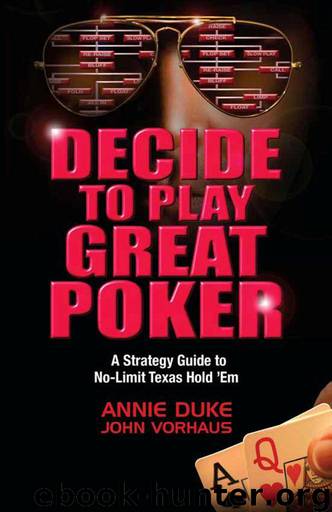Decide to Play Great Poker: A Strategy Guide to No-Limit Texas Hold Em by Duke Annie & Vorhaus John

Author:Duke, Annie & Vorhaus, John [Duke, Annie]
Language: eng
Format: mobi, pdf
Tags: Gambling/Non-fiction
Publisher: Huntington Press
Published: 2011-06-02T16:00:00+00:00
Top Pair, Multi-Way, In Position, With or Without the Lead, Untextured Board
Resetting the situation, you have AQ and you raise on the button. Only now, instead of taking the flop heads-up, you manage to attract three callers. Or you call a raise with AQ, probably suited, and pick up the blinds along the way.
Once again, when talking about multi-way pots, it’s much less important to worry about the pre-flop lead, because when multiple players are in a hand, the lead matters less, while hitting the board matters much more. The lead is an important concept when figuring out who’ll win a pot in which both players miss or improve in a weak way. When four players see a flop, someone improves, so the lead recedes in importance.
Back to the situation at hand: You have AQ in a four-way raised pot and the flop comes untextured, like A-9-3 no suits. Now you’re in a familiar situation in terms of evaluating the strength of your hand. The classes of hands you’re concerned with are AK or better, 9x or AJ or worse, all the way down to Air Jordan. When the board becomes a quandary for your AQ, like this could-be-good or could-be-perilous A-9-3 no suits, all you know is your hand is either way ahead or way behind. Multi-way, the big difference is that if you’re way ahead, there are likely to be more outs against you among the other players’ hands.
Let’s say you have the best hand right now, but you’re against one player holding AJ and another holding 98. If you were heads-up against the AJ, only three outs would be out there against you. Against the 98 alone, there would be five. But if both players are in a pot with you, they have a total of eight outs between them, so the chances of your losing the pot are almost as good as losing to one player on a flush draw. In multi-way pots, even a dry board is essentially textured. And it gets worse as the number of opponents increases. More players equals fewer safe cards for your hand. A textured board, then, has either multiple cards working together or multiple opponents working against you.
With this in mind, we’ll start hunting for ways to reduce texture by reducing these multi-way pots to heads-up situations. Top pair, in particular, really likes being against one player; it’s already hard enough to evaluate. Adding more players to the pot reduces your clarity and you want to do everything you can to increase it.
So here’s you, sitting in position D, as usual.
Download
Decide to Play Great Poker: A Strategy Guide to No-Limit Texas Hold Em by Duke Annie & Vorhaus John.pdf
This site does not store any files on its server. We only index and link to content provided by other sites. Please contact the content providers to delete copyright contents if any and email us, we'll remove relevant links or contents immediately.
The Infinite Retina by Robert Scoble Irena Cronin(6074)
Harry Potter and the Cursed Child: The Journey by Harry Potter Theatrical Productions(4429)
The Sports Rules Book by Human Kinetics(4272)
Molly's Game: From Hollywood's Elite to Wall Street's Billionaire Boys Club, My High-Stakes Adventure in the World of Underground Poker by Molly Bloom(3472)
A Knight of the Seven Kingdoms by George R R Martin(3174)
Quidditch Through the Ages by J.K. Rowling(3052)
How To by Randall Munroe(3016)
Flowers For Algernon by Daniel Keyes(2934)
Quidditch Through the Ages by J K Rowling & Kennilworthy Whisp(2921)
Quidditch Through the Ages by Kennilworthy Whisp by J.K. Rowling(2807)
Stacked Decks by The Rotenberg Collection(2796)
Quidditch through the Ages by J. K. Rowling(2758)
Quidditch Through The Ages by J. K. Rowling(2720)
776 Stupidest Things Ever Said by Ross Petras(2678)
Ready Player One: A Novel by Ernest Cline(2637)
What If?: Serious Scientific Answers to Absurd Hypothetical Questions by Randall Munroe(2626)
Beautiful Oblivion by Jamie McGuire(2556)
The Book of Questions: Revised and Updated by Gregory Stock Ph.d(2502)
Champions of Illusion by Susana Martinez-Conde & Stephen Macknik(2403)
